Let's Get Digital:
My Time in the Digital Humanities
Technology has always been a passion of mine. As a kid, I used to rip apart my parent's computers and televisions to figure out they worked. As early as the third grade, I began exploring creating artistic projects on the computer. I remember emailing my teacher a valentine's card that I had drawn on paper, scanned in, and then overlayed with WordArt on my computer. In middle school, I started editing movies in iMovie and exporting them onto DVDs to play on our old TVs at school. Once high school started, I began to learn how to manipulate images using GIMP and audio using Audacity, as well as filming and editing more advanced videos using Final Cut Pro. Once I got to UNC, I utilized the Undergraduate Library to learn the Adobe Suite and capitalized on UNC's software licensing to learn new programs.
ENGL 480 has been an exciting opportunity for me to creatively explore my interest in technology. I started UNC as a Computer Science major, taking classes on coding and learned Java, but ultimately I felt like the degree was not what I was looking to do for my four years. I ended up switching to the English program but preferred classes that allowed me to be more creative with my work than just writing papers. Past classes have had some overlap between the digital and humanities, but never before have I had the opportunity to fully integrate the two with every assignment. I thoroughly enjoyed having the opportunity to flex my creative muscles and explore new ways to present my research.
DH Report
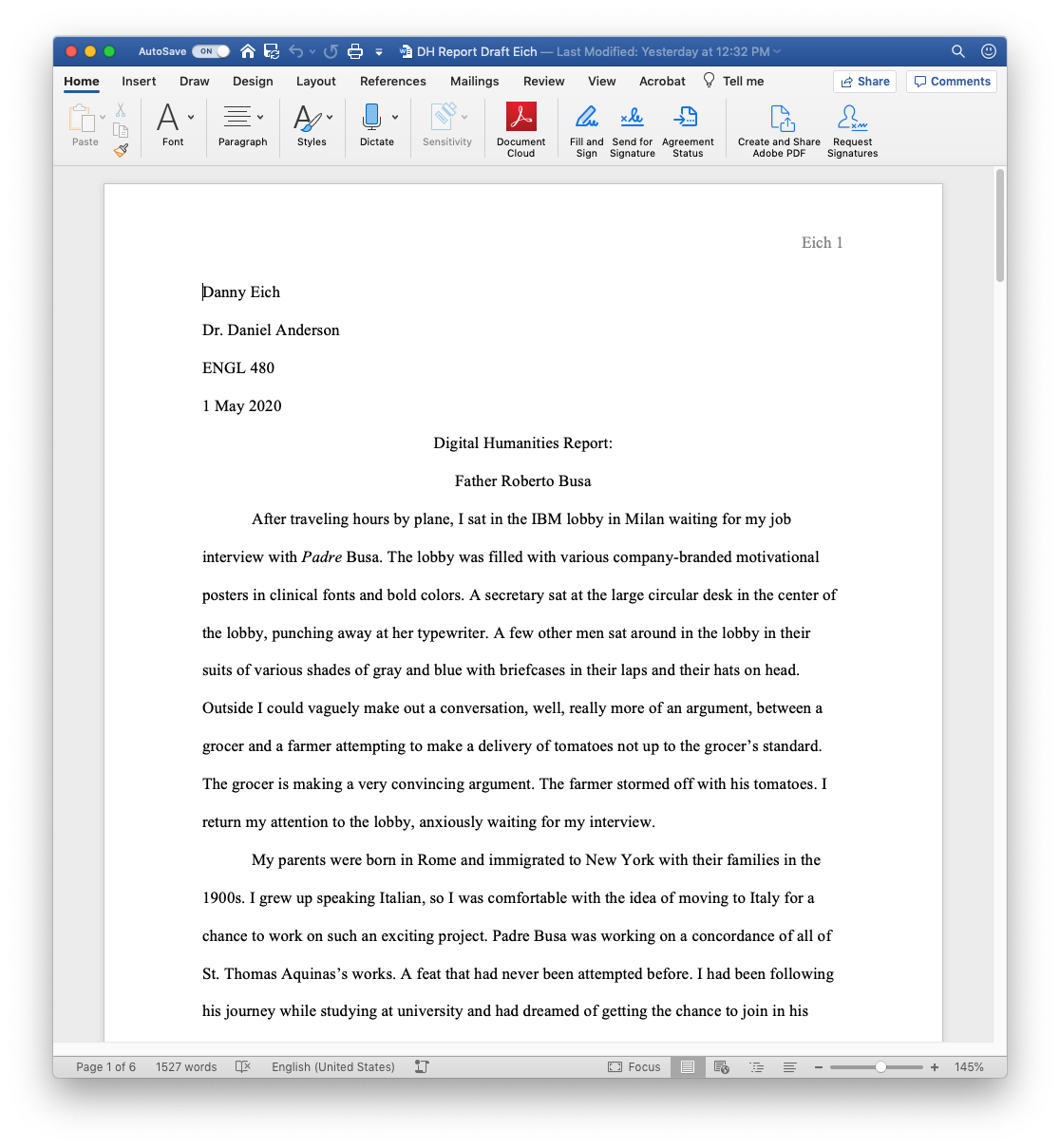
For my DH Report, I was instantly called to research Father Roberto Busa. Busa is considered to be the Father of Digital Humanities, and his research really helped connect what the discipline is all about in my head. Digital humanities are about the overlap between disciplines and reinventing how we analyze the humanities. It is an opportunity for us to mash-up different tools to create new projects. Busa started with a notecard and pen and eventually determined how to repurpose WW2 machines to create his concordance. He had more vision for the future of technology than even the IBM Chairmen he met with had at the time.
For my report, I chose to write the historical fiction of a man coming to Milan to interview for a job under Busa. While waiting in the IBM lobby, the man recounts all of the progress Busa had made in just his ten years since partnering with IBM. He also explains how Busa's prototyped worked, in preparation for his interview.
To read the full report, click here.
DH Project Video
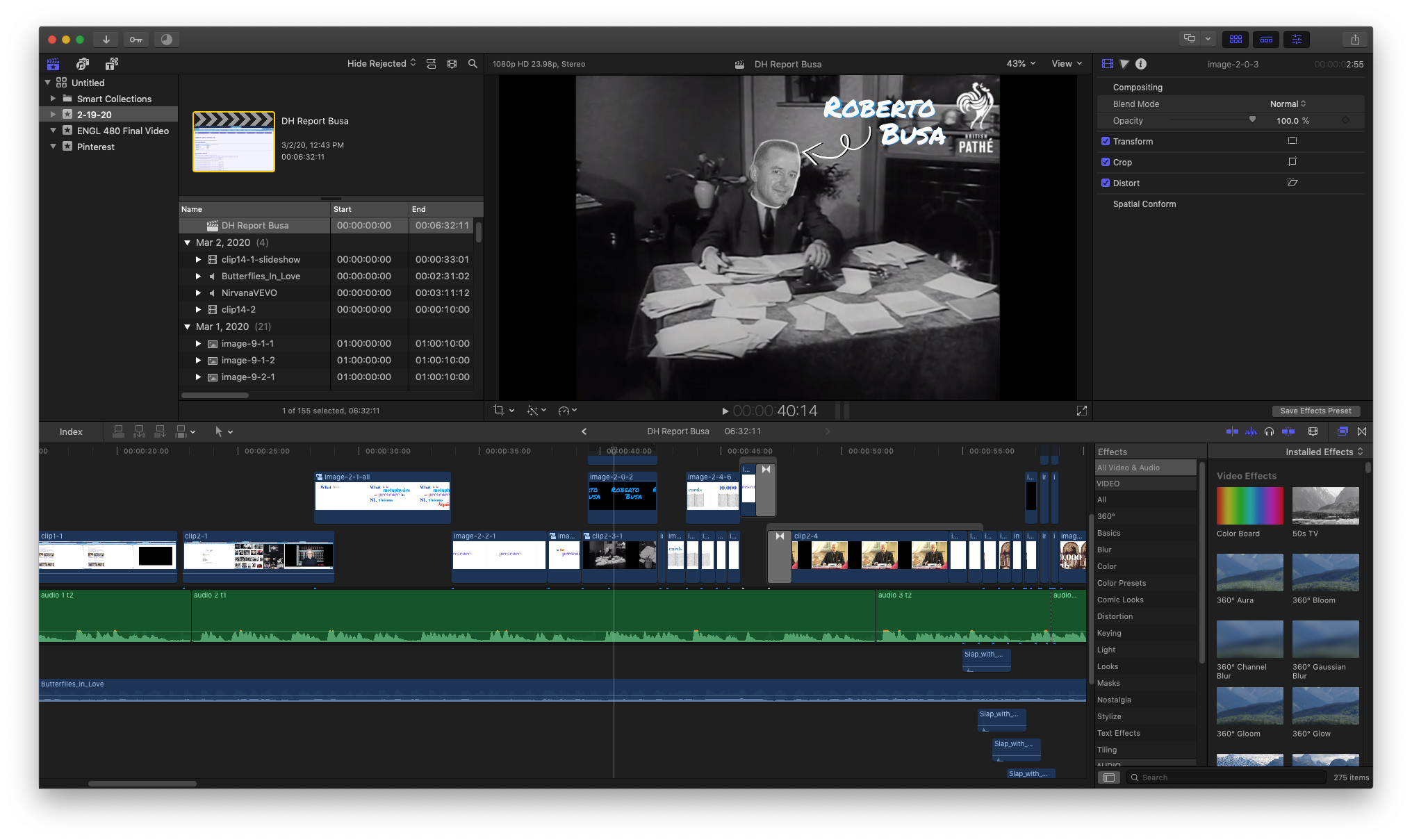
This video project is by far my favorite thing I have made in college, and I am so happy that I get to end my collegiate career with it. When I first started, I was really worried about how I would make a topic that most people would find dull, interesting. Unlike past video projects I had made, I could rely on filming other people and editing together those clips. I would need to figure out how to source each frame and maintain my audience's interest. I also had to deal with a historical topic that most people would not have any background knowledge of (I certainly did not know how punch cards worked before this project), and would need to figure out how to break it down into understandable parts. 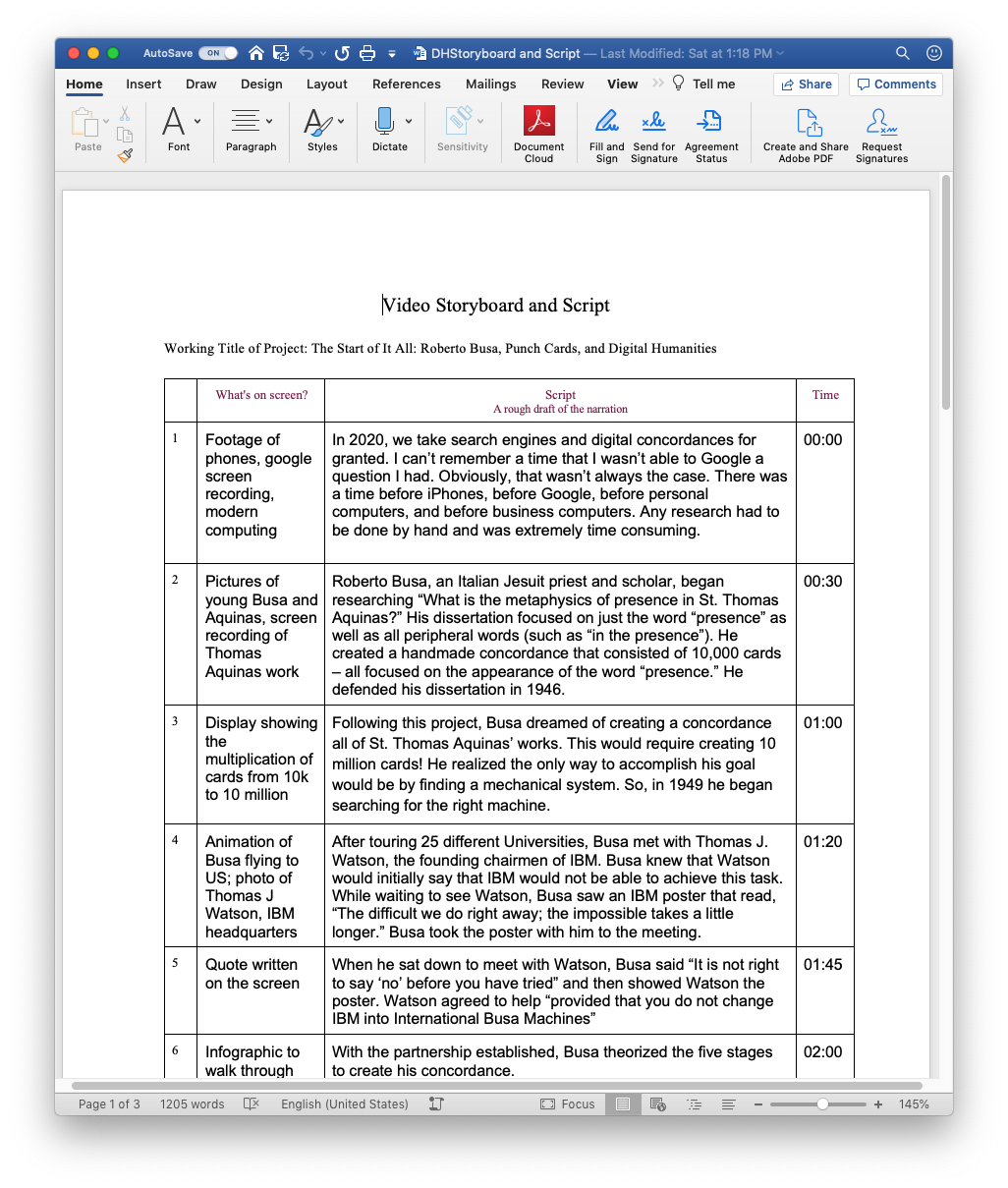
I started with a storyboard and script from a very useful template that Dr. Anderson provided. Using the storyboard, I was able to plan out my video and figure out how I could use visuals to aid in explaining my report. While I did not feel locked down to my storyboard, it created a useful jumping-off point for the rest of the project, and an excellent platform to brainstorm.
The full DH Project Storyboard can be found here.
Once I had a storyboard established, I recorded the narration using Audacity and my webcam. I hate the sound of my voice and I absolutely dreaded having to narrate and edit to my own voice. However, after being forced to listen to myself on repeat for a few hours, I got over this qualm and eventually got used to my voice. Following the storyboard, I recorded each part separately, so I could review roughly 30-second increments to make sure I did not sound like a robot.
With the audio in my Final Cut Pro (FCP) timeline, I had to figure out how to make it visually interesting as well. I searched YouTube to find as much historical footage of the machines as I could and grabbed the files using SnagIt. I used overlays I made in Photoshop to add personality and flair to the stock footage. For scenes where I couldn't find anything, I created animations in Photoshop and PowerPoint. While it sounds complicated, it's really nothing more than a digital flipbook. To keep my editing consistent, I used Adobe Colors to create a color profile and Google Fonts to select a font. Finally, I polished off the video by adding background music and sound effects to audio breaks to the narration.
After finishing the video, I transcribed the video to make the video more accessible. Transcribing also provided an opportunity to make sure my video was coherent. The full transcription can be found here.
Individual Podcast
Our next assignment was to plan, record, and edit a podcast on a Digital Humanities topic. My group's topic was surveillance, artificial intelligence, and algorithms - all topics that I am very passionate about. Leading up to our class recording session, we prepared as a group by finding articles about related issues, discussing our viewpoints as a group, and practicing what we could possibly say. (Our notes can be found here.) We also came up with a name for our podcast, "They're Watching Us," and prepared some speaking points. The time we spent working as a group really helped create a sense of synergy in our podcast and allow us to bounce back and forth from one another like real podcasters. Although I was initially really nervous about recording in front of everyone, I ended up really enjoying it and having a lot of fun.
For my first edit, I cut about 10 minutes of audio out from the original recording, normalized the volume so everyone would sound about the same decibel level, added background music, and tried to cut out verbal clutter (like "um" and coughs). While I had used Audacity in the past, this project was my first time really editing an audio file with it. There is definitely a bit of a learning curve with the software, but once you get into it it's not bad.
For the revision, I further cleaned up the verbal clutter, reduced the volume of some clips, and improved the quality of the main audio track by using the noise reduction effect wherever there was background noise from chair squeaks or people moving in the classroom.
Pinterest Video
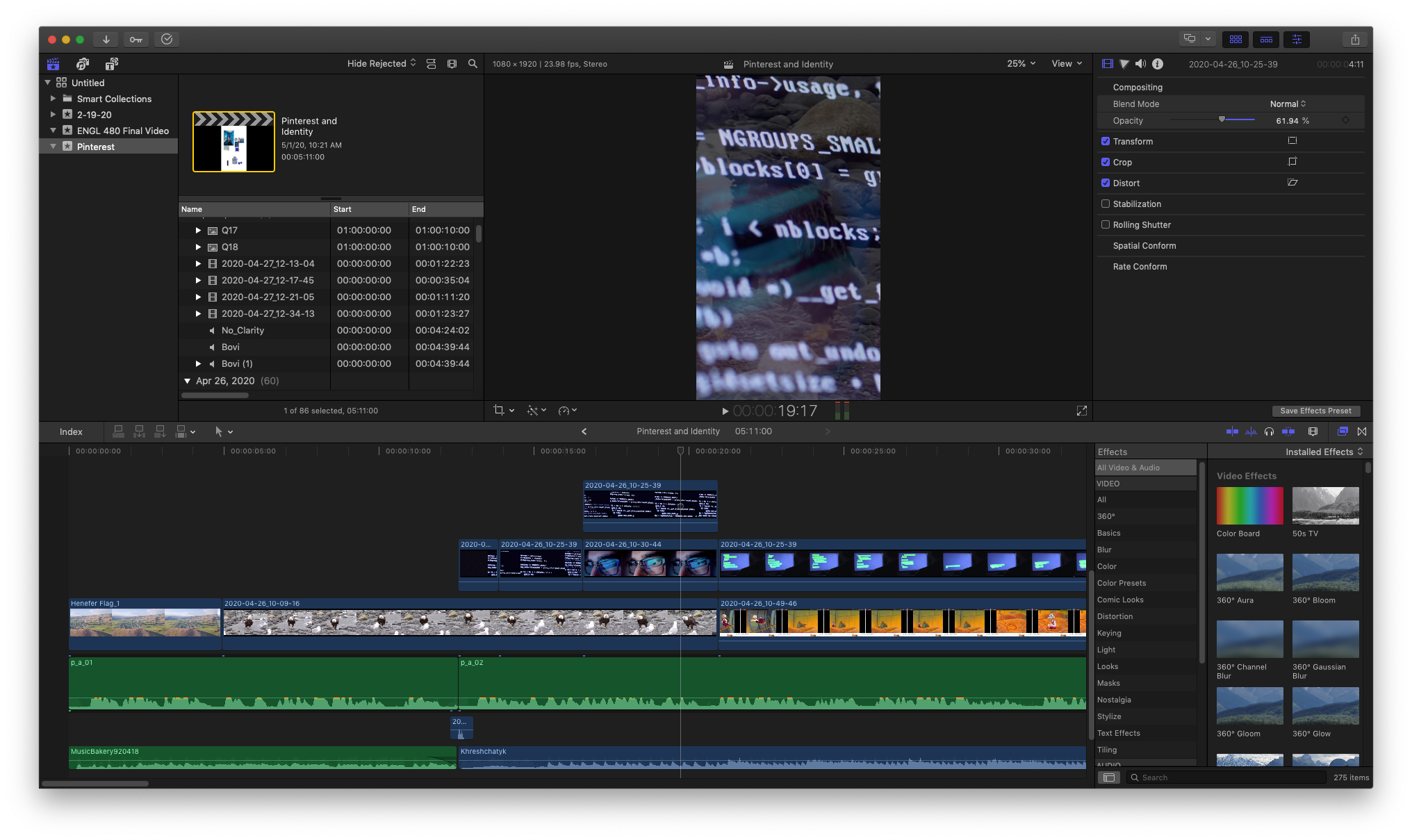
The vertical format is weird. I said it. It seems so natural when I'm watching a Snapchat story, but suddenly ask me to edit in a vertical format and I'm running around like a chicken with its head cut off. That said, it was a fun challenge and it looked really cool watching it on my phone. It just took me a minute to get used to the different format.
Like my other projects, the Pinterest video started with a storyboard. I used the same template as before and practiced reading it out as I went along to get a sense of the timing. Then, I recorded myself using Audacity.
The clips were a little bit harder for me to figure out with this one. Not only did I have less archival footage to work with, but I also had to concentrate on keeping videos centered on the portrait layout. I ended up using a variety of stock footage clips and overlaying them, adjusting the opacity to make them semi-transparent. This provided a sense of variety in my video. I also created some simple animations using Photoshop and made a few collages of the search results.
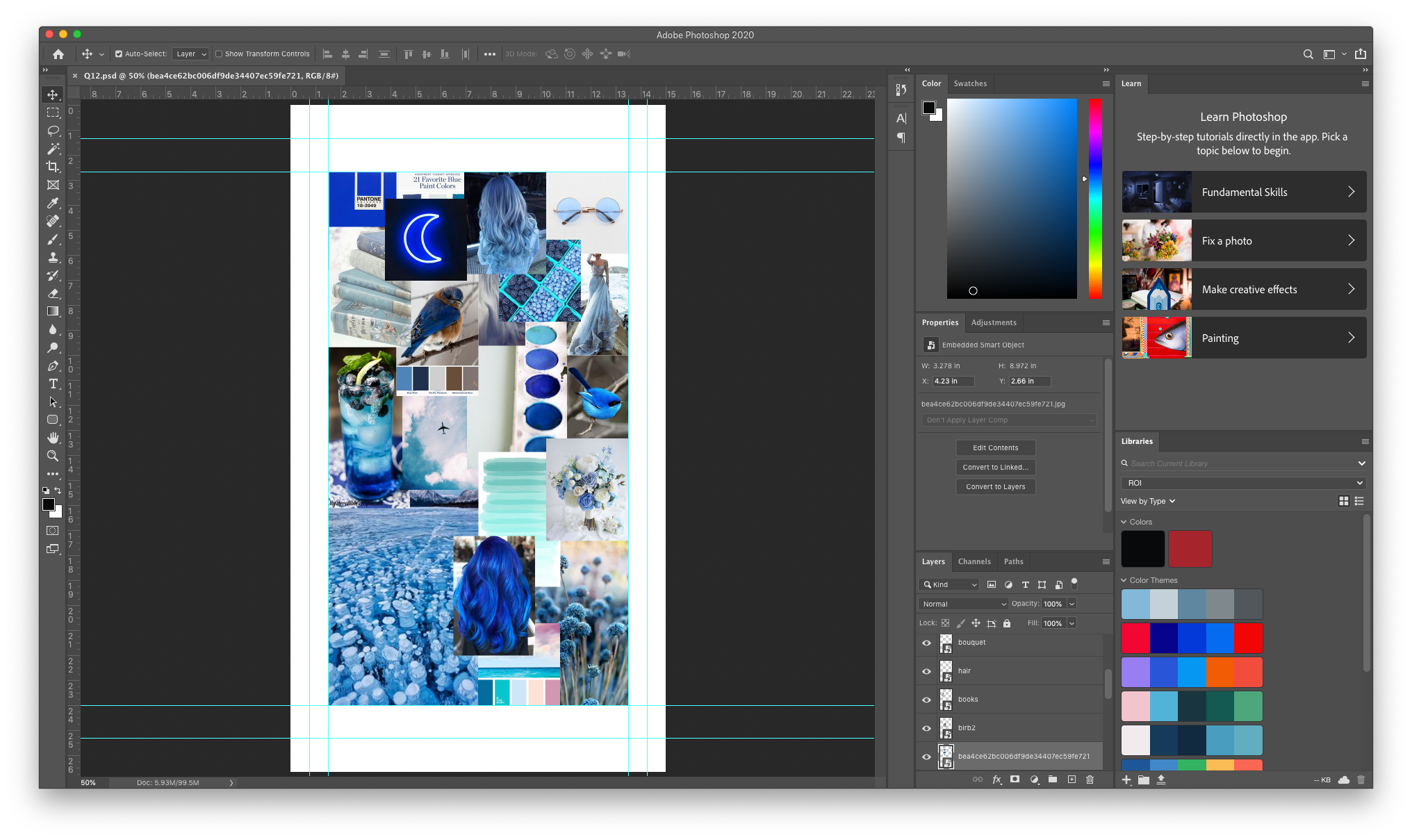
Although challenging, the end result was worth it to me. I enjoyed creating something I had never tried before, and it looks really cool on a mobile device.
Portfolio Video
The final video I made for ENGL 480 is a recap of some of my favorite projects from the class. I began with a storyboard like my other projects. I ended up cutting some between the storyboard and final video to improve the clarity of the video. I used a variety of clips screen recordings (using SnagIt) of my projects, as well as some original content made in Photoshop. I pulled the video together with some visual effects in FCP and background songs from YouTube Audio Library.
Miscellaneous
Comments
Exit Survey
It's crazy to think that my college career has come to an end. I am really thankful for the opportunity to take this class as a part of my final semester and make use of the different skills I have learned across departments. This class became a creative outlet for me during the strange times we are currently living in and I genuinely enjoyed working on every project. Thank you for teaching such a wonderful class, Dr. Anderson!